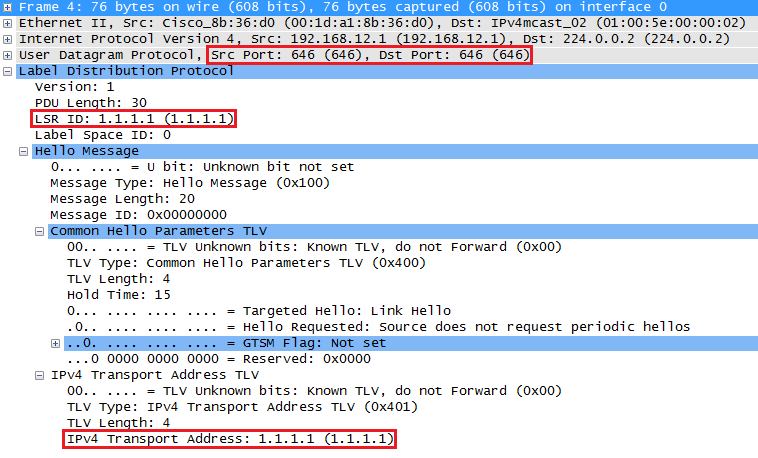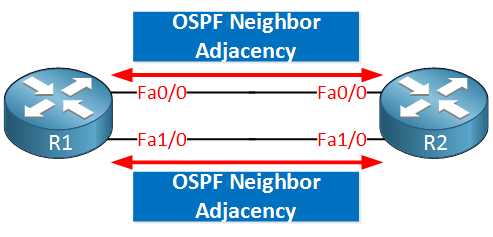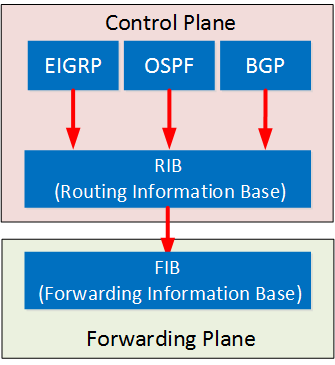LDP is a protocol that automatically generates and exchanges labels between routers. Each router will locally generate labels for its prefixes and will then advertise the label values to its neighbors.
It’s a standard, based on Cisco’s proprietary TDP (Tag Distribution Protocol). It’s pretty much the same story as 802.1Q/ISL or PaGP/LACP. Cisco created a protocol and a standard was created later. Nowadays almost everyone uses LDP instead of TDP.
Like many other protocols, LDP first establishes a neighbor adjacency before it exchanges label information. It works a bit different than most protocols though…
First we send UDP multicast hello packets to discover other neighbors. Once two routers decide to become neighbors, they build the neighbor adjacency using a TCP connection. This connection is then used for the exchange of label information. Normally a loopback interface is used for the neighbor adjacency. Here’s an example:

The two routers above will send multicast hello packets on their FastEthernet interfaces. Within this hello packet, they will advertise a transport IP address. This IP address is then used to establish the TCP connection between the two routers. Here’s what the hello packet looks like in wireshark:

In the capture above you can see a couple of interesting things:
- The hello packets are sent to multicast address 224.0.0.2 using source/destination UDP port 646.
- Each router has a unique ID called the LSR (Label Switch Router) ID. This is similar to how most protocols select an ID, by default it will select the highest IP address on a loopback interface. If you don’t have any loopback interfaces then we will use the highest IP address on a physical interface.
- At the bottom you find the transport address. This is what we use to build the actual TCP connection. Like the LSR ID, the router selected the IP address on the loopback interface as the transport address.
Make sure that the IP address that LDP has selected for the transport address is advertised in your routing protocol. Otherwise your routers will be able to hear each others hello packets but they can’t form a neighbor adjacency since the transport address(es) are unreachable.
This is different compared to how routing protocols like OSPF or EIGRP form neighbor adjacencies. For example, when you run OSPF then your routers will form neighbor adjacencies on all interfaces that run OSPF:

LDP will only form a single neighbor adjacency, no matter how many interfaces you have in between your routers:

LDP is a bit similar to BGP when you use the loopback interfaces for the neighbor adjacency. When we use BGP we have to use the update-source command to select the source, LDP does it automatically.
So once our LDP routers have become neighbors, how do we exchange label information? To explain this, let’s do a quick review of how normal routing uses the RIB and FIB. If you have no idea what these two are then I recommend you to read my CEF lesson first before you continue.

With normal routing, we use routing protocols like EIGRP, OSPF or BGP to learn prefixes from other routers. These are all stored in the RIB (Routing Information Base), this is your routing table.
The information in the RIB is used to build the FIB (Forwarding Information Base) which is what we use for actual forwarding of IP packet. These tables are all used for IP packets but for MPLS we use something else:

When we use LDP on Cisco IOS, we locally generate a label for each prefix that we can find in the RIB, except for BGP prefixes. This information is then added to the LIB (Label Information Base).
The information in the LIB is used to build the LFIB (Label Forwarding Information Base). When the router has to forward a packet with a MPLS label on it, it will use the LFIB for forwarding decisions.
- Unit 1: Introduction
- Unit 2: LDP (Label Distribution Protocol)
- Unit 3: MPLS VPN
- VRFs (Virtual Routing and Forwarding)
- MPLS L3 VPN Explained
- MPLS L3 VPN Configuration
- MPLS L3 VPN BGP Allow AS in
- MPLS L3 VPN BGP AS Override
- MPLS L3 VPN PE-CE RIP
- MPLS L3 VPN PE-CE EIGRP
- MPLS L3 VPN PE-CE OSPF
- MPLS L3 VPN PE-CE OSPF Default Route
- MPLS L3 VPN PE-CE OSPF Global Default Route
- MPLS L3 VPN PE-CE OSPF Sham Link
- VRF Lite Route Leaking
- MPLS VPN Extranet Route Leaking
- MPLS VPN VRF Export Map
- MPLS VPN VRF Import Map
- MPLS over FlexVPN
- Unit 4: MPLS L2 Encapsulation
- Unit 5: IPv6 MPLS
- Unit 6: MPLS Traffic Engineering (TE)
- Introduction to MPLS Traffic Engineering (TE)
- MPLS Traffic Engineering (TE) IS-IS Configuration
- MPLS Traffic Engineering (TE) OSPF Configuration
- MPLS TE RSVP-TE
- MPLS TE Static Routes
- MPLS TE Policy Based Routing (PBR)
- MPLS TE Autoroute Announce
- MPLS TE Autoroute Destination
- MPLS TE Autoroute Metric
- MPLS TE Unequal Cost Load Balancing
- MPLS TE Load Balancing between IGP and TE
- MPLS TE Forwarding Adjacency
- MPLS TE Path Options Explicit
- MPLS TE Class-Based Tunnel Selection (CBTS)
- MPLS TE Metric
- MPLS TE Setup and Hold Priority
- MPLS TE Attribute Flag and Affinity
- MPLS TE Reoptimization
- MPLS TE Fast Reroute (FRR)
- MPLS TE Fast Reroute Path Link Protection
- MPLS TE Fast Reroute Path Node Protection
- MPLS TE FRR RSVP Hello Support
- MPLS TE DiffServ Aware (DS-TE) Traditional
- MPLS TE Diffserv-Aware (DS-TE) IETF Mode
- MPLS VPN over MPLS TE Tunnels
- MPLS TE Per VRF TE tunnel